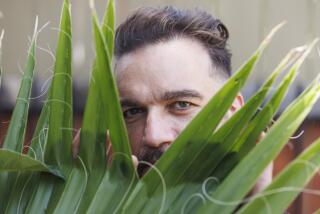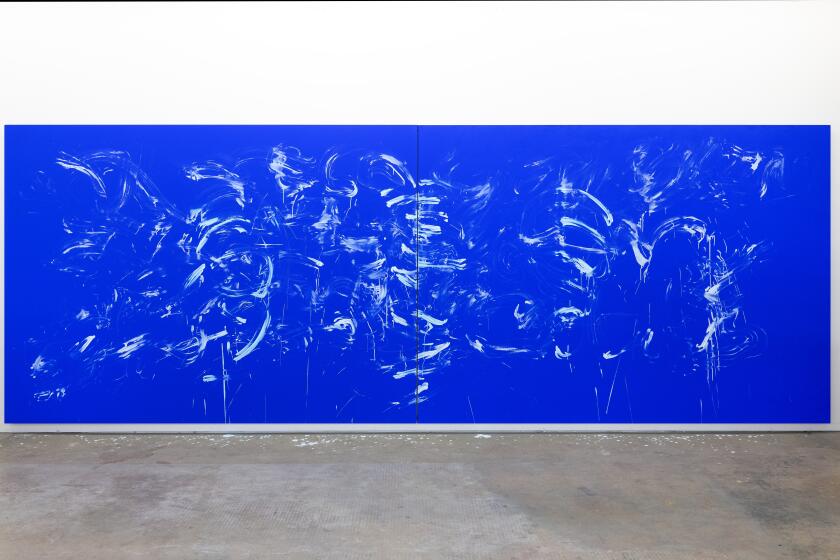‘This Side of Paradise’ at the Huntington Library, Art Collections and Botanical Gardens
A1991 photograph by John Humble shows Selma Avenue at Vine Street as a jumbled, architecturally constructed Hollywood landscape of office buildings, stores, asphalt and advertising billboards. Dominating the center is Angelyne, the cosmetically manufactured “human Barbie doll,” who adorns one enormous sign.
Radio host Rick Dees, then an eternally adolescent 41-year-old, graces a KIIS sign just above her bleached-blond head. Neutered Ken to Angelyne’s pneumatic Barbie, he’s the benign Adam to her wicked Eve in Hollywood’s media-made Garden of Eden.
Humble’s deceptively simple image -- documentary in the most profound sense of that slippery term -- hangs at the entry wall to a large new exhibition at the Huntington Library, Art Collections and Botanical Gardens. Hot on the heels of opening its beautifully refurbished, exquisitely reinstalled mansion, so rich in 18th century European and other art, the Huntington has mounted what is being billed as the most comprehensive show of L.A. photographs ever assembled. It spans the 1860s to the present.
Those dates correspond with two epochal narratives: the history of Los Angeles, incorporated in 1850, and the modern development of the camera, invented almost simultaneously in France and England a scant decade before.
Here’s the thing: France and England had rich visual legacies when the camera came along, but L.A. did not. Los Angeles and photography matured together. “This Side of Paradise: Body and Landscape in L.A. Photographs” perceptively mines that strange and specific relationship.
That’s Fitzgerald
The title is borrowed from F. Scott Fitzgerald’s first novel, whose despairing protagonist laments, “I know myself, but that is all.” The alchemy of the still camera in fabricating perceptions of people and places is an inspired subject for examination. Humble’s picture is emblematic.
The show, like Fitzgerald’s book, is novelistic -- less an art exhibition than a pictorial essay about L.A. as a mediated environment. Its whopping 284 photographs stand in for words.
Artists made many of these pictures, but far from all. The largest group -- 25 photographs -- comes from the “Dick” Whittington Studio, an invaluable commercial outfit that worked for almost every major business and organization in the city between 1924 and 1987, recording L.A.’s explosive growth and commercial development.
Several other commercial photographers are well represented. They include William M. Godfrey, a former Midwest dentist credited with the city’s first photograph (an innocuous 1862 view of downtown’s plaza), and C.C. Pierce, a distinguished architectural photographer, appropriate to a city powered by waves of real estate speculation.
William A. Garnett’s aerial chronicle of the postwar construction of suburban Lakewood is nearly Minimalist in its organized geometry. (Implausibly, Garnett got his start working in the Pasadena Police Department’s photography lab.) G. Haven Bishop’s 1915 street scene of a downtown neon advertisement reverberates against Humble’s 1991 Hollywood view, but Bishop’s nocturnal photograph is part of Southern California Edison’s corporate archive, documenting the urbanizing effects of electricity.
The next largest group -- 19 photographs -- was made by arguably the greatest 19th century American landscape photographer, Carleton E. Watkins. Although better known for his classically ordered views of Northern California and Nevada, in which a rustic dam or mountain plateau is endowed with the noble gravity of the Parthenon, Watkins’ two L.A. excursions resulted in languid vistas of Santa Monica Canyon and Pasadena farmland. Sylvan southern harmonies supplant rustic northern dramas.
Among postwar photographers, the two most abundantly represented are Harry Gamboa Jr. and Gusmano Cesaretti. Gamboa’s well-known series of Chicano portraits plays off cultural stereotypes, promulgated by mass media. Cesaretti is a visual consultant who pulls those mass-media levers, most notably with film and TV producer-directors Michael Mann and Tony Scott.
Disappointingly, just 18 of the 108 named photographers are women. Glamour photographer George Hurrell is unsurprisingly included, for example, but not his MGM predecessor, Ruth Harriet Louise. More men than women would be expected, given social norms of the last 150 years, but the disparity is greater than it should be.
The show is not organized chronologically or by artist. The seven visual essays are instead thematic, beginning with a selection in the library’s West Hall that looks at L.A.’s reputation as an artificial garden.
An Edenic vista is framed by such works as Pierce’s panoramic 1910 view of the Cahuenga Pass, all rolling hills dotted with farmhouses. The pervasiveness of the pastoral idyll subtly recasts Herb Ritts’ pair of sensual portraits of male and female fashion models as iconic images of humanity’s tragic fall, a blend of Angelyne and Dees. Ditto Larry Sultan’s porn actors in a middle-class Valley backyard and Anthony Friedkin’s deluxe patrons at the Beverly Hills Hotel swimming pool.
The remainder of the show, installed in the Boone Gallery a short stroll from the library, is cleverly reached by ambling through portions of the Huntington’s own celebrated gardens. Artist Allan Sekula was commissioned to create a visual link between the two spaces.
He responded with a sequence of 15 small garden “billboards.” Some are provocative. A neon bus sign lets you know your experience is being stage-managed (“Go Greyhound, and leave the driving to us”), while a woman with a mop in a tatty domestic driveway puts as careworn face on the unsung drudgery that keeps ordinary life going.
The Boone Gallery rolls out themes of work, home, play, aspiration and conflict -- and, of course, car culture. Each is multifaceted, with selections assembled like curatorial collages. Juxtapositions recognize that photographs, unlike paintings, are inherently linked to a world outside themselves.
Take one series in “Work,” which opens with Imogen Cunningham’s 1932 portrait of actor Spencer Tracy on an unidentified movie set. Next to it is Edward Weston’s pair of rubber dummies on the MGM back lot, followed by two hyper-masculine beefcake pictures by Robert Mizer, underground publisher of the homoerotic magazine Physique Pictorial. Ansel Adams’ adjacent picture shows female movie mannequins severed into pieces, which resonates with Peter Stackpole’s 1938 picture of two dames in bathing suits, hoping for work as movie extras.
This gendered acting sequence culminates in Philippe Halsman’s 1952 “Marilyn With Barbells.” Monroe lies on a bench working her pectoral muscles, conjuring a different type of physique pictorial.
A city that moves
“Move” reconfigures car-culture clichés in 18 pictures that riff on street photography. There’s the classic version -- say, the freely swinging camera of Garry Winogrand, which tilts and destabilizes ordinary urban views. Then there’s the Pop Art pun on a street photograph: Ed Ruscha’s 21-foot-long accordion of snapshots, together showing “Every Building on the Sunset Strip.”
Finally, absurdist humor doesn’t get any better than the pairing of printed dialogue with self-portrait photographs of Conceptual artist Allan Ruppersberg affably asking other pedestrians for directions -- “You go down Sunset to La Brea. Right on La Brea to . . . .” People on foot cope in a city organized around cars.
The “play” section includes pictures of iconic L.A. recreation -- surfing, cycling, hiking -- as well as theater (playacting), music along Central Avenue (playing jazz) and, unexpectedly, masturbation (a porn actress with her hand down her pants). The effect of these juxtapositions is to sharpen attention -- no mean feat in a world where photographs are as ubiquitous in daily experience as nature used to be.
Perhaps that helps to explain the quirky installation design by accomplished architects Kevin Daly and Chris Genik, which takes some getting used to. In addition to a conventional hanging of framed pictures on sky blue walls, they’ve built metal display stands that are biomorphic -- abstractions evoking organic plants. Each “stem” is topped by a framed photograph, like a rather ugly industrial flower.
More than 40% of the show comes from the Huntington’s own collections, a vast archive numbering some 500,000 images. Huntington curator Jennifer Watts and independent curator Claudia Bohn-Spector have also borrowed works from 50 other public and private collections. Whether these photographs together evince a distinct Los Angeles style of visual expression is difficult to say. But “This Side of Paradise” is certainly a very good read.
christopher.knight @latimes.com
More to Read
The biggest entertainment stories
Get our big stories about Hollywood, film, television, music, arts, culture and more right in your inbox as soon as they publish.
You may occasionally receive promotional content from the Los Angeles Times.











